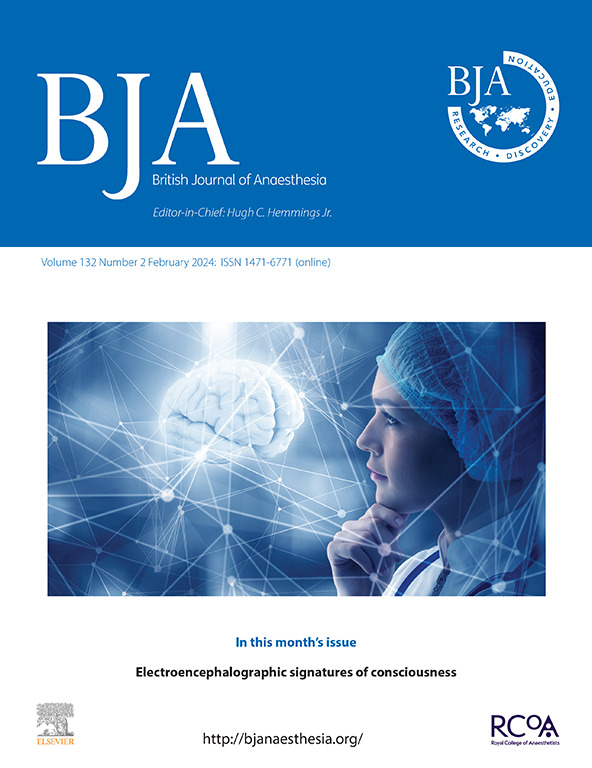四肽治疗产妇硬脊膜穿刺后头痛无效果:一项双盲随机对照临床试验。
IF 9.1
1区 医学
Q1 ANESTHESIOLOGY
引用次数: 0
摘要
背景:硬脊膜后穿刺头痛(PDPH)是产科神经轴麻醉的常见并发症。尽管硬膜外血液贴片(EBP)仍然是最有效的治疗方法,但人们正在探索侵入性较小的替代方法。我们评估了四糖苷(一种合成促肾上腺皮质激素类似物)治疗产后PDPH患者的有效性和安全性。方法采用随机、双盲、安慰剂对照的方法,在两所三级妇产医院进行临床试验。产后PDPH患者接受轴向麻醉后随机分组,接受四糖苷1mg静脉注射或安慰剂。主要观察指标为15天随访期间EBP发生率。次要结局包括头痛持续时间和强度、活动限制、住院时间和每位患者执行ebp的次数。计划在50%入组时进行中期分析以确定无效和试验终止。结果纳入的44例患者(治疗组23例,安慰剂组21例)的中期分析显示,主要结局无显著差异:治疗组21例(91%)患者接受EBP治疗,安慰剂组18例(86%)患者接受EBP治疗(P=0.6575)。除治疗组住院时间延长1天(P=0.0486)外,两组间的次要结局具有可比性。这项研究因无效而终止。未观察到四糖苷给药的副作用。结论单剂量四环星苷对预防产后PDPH患者EBP需求无明显效果,对头痛强度、头痛持续时间和体力活动限制无影响。鉴于这些发现,促肾上腺皮质激素类似物不应考虑用于这一适应症。欧盟临床试验注册(2015-003357-17);ClinicalTrials.gov (NCT02813655);法国国家桑普拉斯和桑普拉斯与产品管理局(160214A-31)。本文章由计算机程序翻译,如有差异,请以英文原文为准。
No effect of tetracosactide for treatment of postdural puncture headaches in parturient women: a double-blind randomised controlled clinical trial.
BACKGROUND
Postdural puncture headache (PDPH) is a common complication of neuraxial anaesthesia in obstetrics. Although epidural blood patch (EBP) remains the most effective treatment, less invasive alternatives are being explored. We assessed the efficacy and safety of tetracosactide, a synthetic adrenocorticotropic hormone analogue, for treating established PDPH in postpartum patients.
METHODS
A randomised, double-blind, placebo-controlled trial was conducted in two tertiary care maternal hospitals. Postpartum patients with PDPH after neuraxial anaesthesia were randomised to receive either tetracosactide 1 mg i.v. or placebo. The primary outcome was the rate of EBP within the 15-day follow-up. Secondary outcomes included headache duration and intensity, activity limitation, length of hospital stay, and the number of EBPs performed per patient. Interim analysis to determine futility and trial termination was planned at 50% enrolment.
RESULTS
At interim analysis with 44 patients enrolled (23 in the treatment group and 21 in the placebo group) no significant difference was found for the primary outcome: 21 (91%) patients in the treatment group and 18 (86%) patients in the placebo group received EBP (P=0.6575). Secondary outcomes were comparable between groups, except for a 1-day longer hospital stay in the treatment group (P=0.0486). The study was terminated because of futility. No side-effects of tetracosactide administration were observed.
CONCLUSIONS
A single dose of tetracosactide did not demonstrate efficacy in preventing EBP needs in postpartum PDPH, and there was no effect on the intensity, duration of headaches, and physical activity limitations. Given these findings, adrenocorticotropic hormone analogues should not be considered for this indication.
CLINICAL TRIAL REGISTRATION
European Union Clinical Trials Register (2015-003357-17); ClinicalTrials.gov (NCT02813655); French Agence Nationale de Sécurité du Médicament et des Produits de Santé (160214A-31).
求助全文
通过发布文献求助,成功后即可免费获取论文全文。
去求助
来源期刊
CiteScore
13.50
自引率
7.10%
发文量
488
审稿时长
27 days
期刊介绍:
The British Journal of Anaesthesia (BJA) is a prestigious publication that covers a wide range of topics in anaesthesia, critical care medicine, pain medicine, and perioperative medicine. It aims to disseminate high-impact original research, spanning fundamental, translational, and clinical sciences, as well as clinical practice, technology, education, and training. Additionally, the journal features review articles, notable case reports, correspondence, and special articles that appeal to a broader audience.
The BJA is proudly associated with The Royal College of Anaesthetists, The College of Anaesthesiologists of Ireland, and The Hong Kong College of Anaesthesiologists. This partnership provides members of these esteemed institutions with access to not only the BJA but also its sister publication, BJA Education. It is essential to note that both journals maintain their editorial independence.
Overall, the BJA offers a diverse and comprehensive platform for anaesthetists, critical care physicians, pain specialists, and perioperative medicine practitioners to contribute and stay updated with the latest advancements in their respective fields.

 求助内容:
求助内容: 应助结果提醒方式:
应助结果提醒方式:


